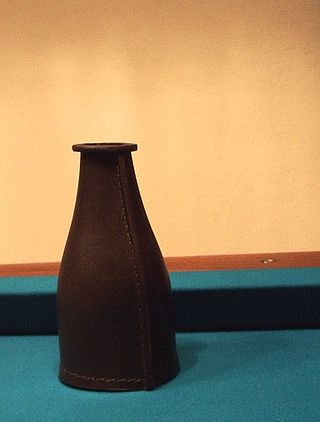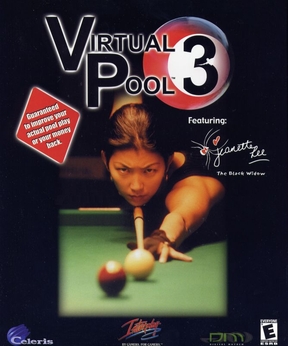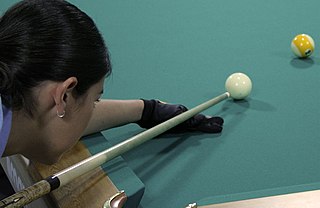
Cue sports are a wide variety of games of skill played with a cue, which is used to strike billiard balls and thereby cause them to move around a cloth-covered table bounded by elastic bumpers known as cushions. Cue sports are also collectively referred to as billiards, though this term has more specific connotations in some varieties of English.

English billiards, called simply billiards in the United Kingdom and in many former British colonies, is a cue sport that combines the aspects of carom billiards and pool. Two cue balls and a red object ball are used. Each player or team uses a different cue ball. It is played on a billiards table with the same dimensions as one used for snooker and points are scored for cannons and pocketing the balls.

Straight pool, which is also called 14.1 continuous and 14.1 rack, is a cue sport in which two competing players attempt to pocket as many object balls as possible without playing a foul. The game was the primary version of pool played in professional competition until it was superseded by faster-playing games like nine-ball and eight-ball in the 1980s.

Carom billiards, also called French billiards and sometimes carambole billiards, is the overarching title of a family of cue sports generally played on cloth-covered, pocketless billiard tables. In its simplest form, the object of the game is to score points or "counts" by caroming one's own cue ball off both the opponent's cue ball and the object ball on a single shot. The invention as well as the exact date of origin of carom billiards is somewhat obscure but is thought to be traceable to 18th-century France.

Russian pyramid, also known as Russian billiards, is a form of billiards played on a large billiard table with narrow pockets. It is played across Russia and several former Soviet/Eastern Bloc countries. In the West, the game is known as pyramid billiards, or simply pyramid.

Straight rail, also called straight billiards, three-ball billiards, or the free game, is a discipline of carom billiards that is the most basic form of the game. The game is played on a pocketless unmarked billiard table, usually 10 by 5 feet in size, and three billiard balls, one, usually white, that serves as the cue ball for the first player, a second cue ball for the second player, and an object ball, usually red. The object of the game is to score points by striking the player's assigned cue ball with a cue stick so it makes contact with both the opponent's cue ball and the object ball in the same stroke, known as a carom. Games are played to a predetermined number of points.

A billiard table or billiards table is a bounded table on which cue sports are played. In the modern era, all billiards tables provide a flat surface usually made of quarried slate, that is covered with cloth, and surrounded by vulcanized rubber cushions, with the whole thing elevated above the floor. More specific terms are used for specific sports, such as snooker table and pool table, and different-sized billiard balls are used on these table types. An obsolete term is billiard board, used in the 16th and 17th centuries.

Pool is a series of cue sports played on a billiard table. The table has six pockets along the rails, into which balls are shot. Of the many different pool games, the most popular include: eight-ball, blackball, nine-ball, ten-ball, seven-ball, straight pool, one-pocket, and bank pool. Eight-ball is the most frequently played discipline of pool, and it is often thought of as synonymous with "pool".

Four-ball billiards or four-ball carom is a carom billiards game, played on a pocketless table with four billiard balls, usually two red and two white, one of the latter with a spot to distinguish it. Each player is assigned one of the white balls as a cue ball. A point is scored when a shooter's cue ball caroms on any two other balls in the same shot. Two points are scored when the shooter caroms on each of the three object balls in a single shot. A carom on only one ball results in no points, and ends the shooter's inning.
The following is a glossary of traditional English-language terms used in the three overarching cue sports disciplines: carom billiards referring to the various carom games played on a billiard table without pockets; pool, which denotes a host of games played on a table with six pockets; and snooker, played on a large pocket table, and which has a sport culture unto itself distinct from pool. There are also games such as English billiards that include aspects of multiple disciplines.

FooBillard is a free and open-source, OpenGL-based sports simulation video game.
Honolulu, also known as banks, kisses, and combinations or indirect, is a pocket billiards game. Players must pocket all shots in an indirect fashion to reach a set number of points. The game shares some similarities with other cue sports, played on tables and with balls used for pool, but differs with foul points being awarded for regular direct shots.

Five-pin billiards or simply five-pins or 5-pins, is today usually a carom billiards form of cue sport, though sometimes still played on a pocket table. In addition to the customary three balls of most carom games, it makes use of a set of five upright pins (skittles) arranged in a "+" pattern at the center of the table. The game is popular especially in Italy and Argentina, but also in some other parts of Latin America and Europe, with international, televised professional tournaments. It is sometimes referred to as Italian five-pins or Italian billiards, or as simply italiana. A variant of the game, goriziana or nine-pins, adds additional skittles to the formation. A related pocket game, with larger pins, is played in Scandinavia and is referred to in English as Danish pin billiards, with a Swedish variant that has some rules more similar to the Italian game.

Bottle pool is a billiards game. It combines aspects of both carom and pocket billiards. Played on a standard pool table, the game utilizes three balls and a narrow-necked bottle called a shake or tally bottle. The bottle is traditionally made from leather, and is placed on the table and used as a target for caroms. Those unfamiliar with the game sometimes mistakenly use its name as a synonym for the very different game of kelly pool.

Virtual Pool 3 is a 3D, first-person sports video game that simulates various cue sports, developed and released for Windows and PlayStation by Celeris. The game features 15 pool disciplines, snooker, and two varieties of carom billiards.

Virtual Pool is a 3D, first-person sports simulation video game series with computer simulations of cue sports which was developed by Celeris. The games in the series simulate pool, snooker and carom billiards. The Virtual Pool series focuses on accurate simulation and improving the player's ability to play the sport in real life. Virtual Pool releases are sold with a money back guarantee to improve a player's external game.

Pool Revolution: Cue Sports is a sports simulation video game video game published by Hudson Soft for the Wii's WiiWare service. The game simulates a variety of cue sports.
Carom billiards and pool are two types of cue sports or billiards-family games, which as a general class are played with a stick called a cue which is used to strike billiard balls, moving them around a cloth-covered billiard table bounded by rubber cushions attached to the confining rails of the table.

A cue stick is an item of sporting equipment essential to the games of pool, snooker and carom billiards. It is used to strike a ball, usually the cue ball. Cues are tapered sticks, typically about 57–59 inches long and usually between 16 and 21 ounces (450–600 g), with professionals gravitating toward a 19-ounce (540 g) average. Cues for carom tend toward the shorter range, though cue length is primarily a factor of player height and arm length. Most cues are made of wood, but occasionally the wood is covered or bonded with other materials including graphite, carbon fiber or fiberglass. An obsolete term for a cue, used from the 16th to early 19th centuries, is billiard stick.
Slosh is a cue sport played on a snooker table. The game features seven balls, coloured white, yellow, green, brown, blue, pink and black, with points being scored for pocketing or playing caroms and cannons off object balls. The game is played to a score of 100 points, or a length of 30 minutes. First played in the early 1900s, not much is known about the game's origins.
















